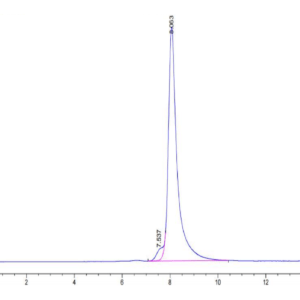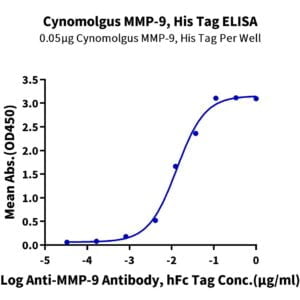| Weight | 1 lbs |
|---|---|
| Dimensions | 9 × 5 × 2 in |
| accession | NP_004435.3 |
| express system | HEK293 |
| product tag | C-His |
| purity | > 95% as determined by Tris-Bis PAGE;> 95% as determined by HPLC |
| background | The erythropoietin-producing hepatocellular carcinoma (Eph) receptors are the largest family of receptor tyrosine kinases (RTKs) that include two major subclasses, EphA and EphB. They form an important cell communication system with critical and diverse roles in a variety of biological processes during embryonic development. The emerging picture suggests that EphB4 is a valuable and attractive therapeutic target for upper aerodigestive malignancies. |
| molecular weight | The protein has a predicted MW of 58.2 kDa. Due to glycosylation, the protein migrates to 60-70 kDa based on Tris-Bis PAGE result. |
| available size | 100 µg, 500 µg |
| endotoxin | Less than 1EU per μg by the LAL method. |
Human EphB4 Protein 4146
$150.00 – $500.00
Summary
- Expression: HEK293
- Pure: Yes (HPLC)
- Amino Acid Range: Leu16-Ala539
Human EphB4 Protein 4146
| protein |
|---|
| Size and concentration 100, 500µg and lyophilized |
| Form Lyophilized |
| Storage Instructions Valid for 12 months from date of receipt when stored at -80°C. Recommend to aliquot the protein into smaller quantities for optimal storage. Please minimize freeze-thaw cycles. |
| Storage buffer Shipped at ambient temperature. |
| Purity > 95% as determined by Tris-Bis PAGE |
| target relevance |
|---|
| The erythropoietin-producing hepatocellular carcinoma (Eph) receptors are the largest family of receptor tyrosine kinases (RTKs) that include two major subclasses, EphA and EphB. They form an important cell communication system with critical and diverse roles in a variety of biological processes during embryonic development. The emerging picture suggests that EphB4 is a valuable and attractive therapeutic target for upper aerodigestive malignancies. |
| Protein names Ephrin type-B receptor 4 (EC 2.7.10.1) (Hepatoma transmembrane kinase) (Tyrosine-protein kinase TYRO11) |
| Protein family Protein kinase superfamily, Tyr protein kinase family, Ephrin receptor subfamily |
| Mass 108270Da |
| Function Receptor tyrosine kinase which binds promiscuously transmembrane ephrin-B family ligands residing on adjacent cells, leading to contact-dependent bidirectional signaling into neighboring cells. The signaling pathway downstream of the receptor is referred to as forward signaling while the signaling pathway downstream of the ephrin ligand is referred to as reverse signaling. Together with its cognate ligand/functional ligand EFNB2 it is involved in the regulation of cell adhesion and migration, and plays a central role in heart morphogenesis, angiogenesis and blood vessel remodeling and permeability. EPHB4-mediated forward signaling controls cellular repulsion and segregation from EFNB2-expressing cells. {ECO:0000269|PubMed:12734395, ECO:0000269|PubMed:16424904, ECO:0000269|PubMed:27400125, ECO:0000269|PubMed:30578106}. |
| Catalytic activity CATALYTIC ACTIVITY: Reaction=ATP + L-tyrosyl-[protein] = ADP + H(+) + O-phospho-L-tyrosyl-[protein]; Xref=Rhea:RHEA:10596, Rhea:RHEA-COMP:10136, Rhea:RHEA-COMP:10137, ChEBI:CHEBI:15378, ChEBI:CHEBI:30616, ChEBI:CHEBI:46858, ChEBI:CHEBI:82620, ChEBI:CHEBI:456216; EC=2.7.10.1; Evidence={ECO:0000255|PROSITE-ProRule:PRU10028}; |
| Subellular location Cell membrane {ECO:0000269|PubMed:28687708, ECO:0000269|PubMed:8188704}; Single-pass type I membrane protein {ECO:0000269|PubMed:8188704}. |
| Tissues Abundantly expressed in placenta but also detected in kidney, liver, lung, pancreas, skeletal muscle and heart. Expressed in primitive and myeloid, but not lymphoid, hematopoietic cells. Also observed in cell lines derived from liver, breast, colon, lung, melanocyte and cervix. {ECO:0000269|PubMed:8188704}. |
| Structure Heterotetramer upon binding of the ligand. The heterotetramer is composed of an ephrin dimer and a receptor dimer. Oligomerization is probably required to induce biological responses (By similarity). Interacts with RASA1; the interaction depends on EPHB4 tyrosine-phosphorylation (PubMed:30578106). {ECO:0000250, ECO:0000269|PubMed:30578106}. |
| Post-translational modification Phosphorylated; autophosphorylation is stimulated by EFNB2. |
| Target Relevance information above includes information from UniProt accession: P54760 |
| The UniProt Consortium |
Data
 |
| The purity of Human EphB4 is greater than 95% as determined by SEC-HPLC. |
 |
| Human EphB4 on Tris-Bis PAGE under reduced condition. The purity is greater than 95%. |
Publications
Publications
| pmid | title | authors | citation |
|---|---|---|---|
| We haven't added any publications to our database yet. | |||
Protocols
| relevant to this product |
|---|
Documents
| # | ||
|---|---|---|
| Please enter your product and batch number here to retrieve product datasheet, SDS, and QC information. | ||














